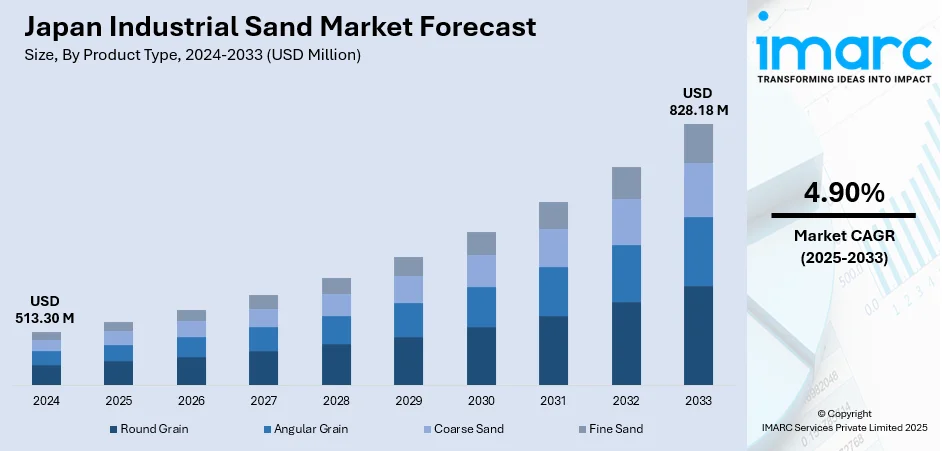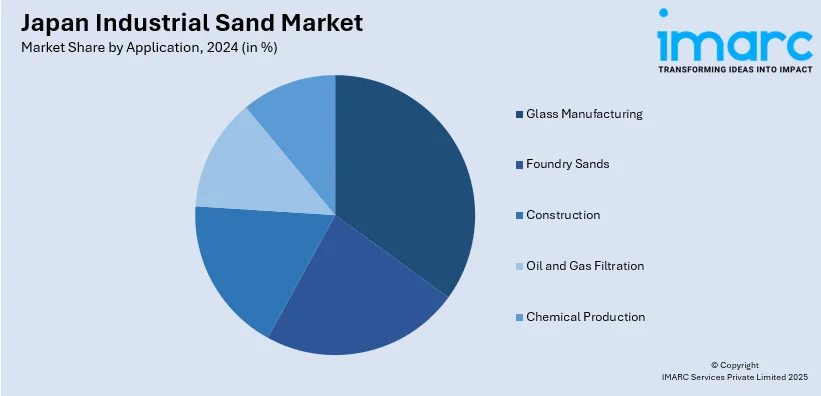
Japan Industrial Sand Market Size, Share, Trends and Forecast by Product Type, Grade, Application, End Use, and Region, 2025-2033
Japan Industrial Sand Market Overview:
The Japan industrial sand market size reached USD 513.30 Million in 2024. Looking forward, IMARC Group expects the market to reach USD 828.18 Million by 2033, exhibiting a growth rate (CAGR) of 4.90% during 2025-2033. The market is driven by sustained demand for high-purity sand from Japan’s semiconductor and precision electronics industries. Ongoing requirements in glass manufacturing for architectural, solar, and packaging purposes reinforce consistent consumption, thereby fueling the market. The country’s dependence on quality-assured imports shapes specialized sourcing strategies, further augmenting the Japan industrial sand market share.
|
Report Attribute
|
Key Statistics
|
|---|---|
|
Base Year
|
2024
|
|
Forecast Years
|
2025-2033
|
|
Historical Years
|
2019-2024
|
| Market Size in 2024 | USD 513.30 Million |
| Market Forecast in 2033 | USD 828.18 Million |
| Market Growth Rate 2025-2033 | 4.90% |
Japan Industrial Sand Market Trends:
Steady Demand from the Semiconductor and Electronics Sector
Japan’s globally influential semiconductor and electronics industries are key end-users of high-purity silica sand, which is critical in the production of silicon wafers and specialized glass. The demand for ultrapure sand with controlled particle sizes and minimal impurities remains stable, driven by advancements in chip design, miniaturization, and sensor development. With Japan’s continued leadership in automotive electronics, robotics, and high-speed computing, the need for materials with superior thermal and chemical properties has increased. Manufacturers require low-iron content sand to meet exacting standards in wafer fabrication and flat-panel display production. Domestic glassmakers supplying cover glass for smartphones and tablets also source precision-processed sand for clarity and durability. On 25 March 2024, AGC Inc. announced it had successfully completed Japan’s first demonstration test recycling solar panel cover glass into float glass, using approximately 5 tons of material at its Kashima Plant. This breakthrough addresses a major waste issue, as cover glass makes up 60% of a solar panel’s weight and hundreds of thousands of tons are projected to be discarded annually starting in the late 2030s. The recycling process conserves silica sand and soda ash, key raw materials for Japan's industrial sand market, and is expected to reduce CO₂ emissions by 0.5 to 0.7 tons per ton of glass produced. As Japan strengthens its domestic chip manufacturing ecosystem through subsidies and public-private partnerships, industrial sand suppliers are aligning their operations to support local needs. Enhanced processing facilities and quality control mechanisms have become vital to meet strict technical specifications. These developments support a consistent procurement flow from Japanese electronics manufacturers. The strong linkage between innovation-driven manufacturing and specialty mineral inputs continues to influence Japan industrial sand market growth, particularly as the country seeks to reduce reliance on imports for critical tech materials.

To get more information on this market, Request Sample
Glass Manufacturing and Architectural Applications
Industrial sand plays a foundational role in Japan’s glass manufacturing industry, which produces architectural glass, container glass, and specialized types such as borosilicate and laminated variants. Given Japan’s stringent energy efficiency regulations and architectural codes, the demand for insulated, reflective, and low-emissivity glass has risen in both residential and commercial segments. High-quality silica sand is a primary input in ensuring clarity, strength, and heat resistance in these products. On 19 December 2024, Mitsubishi Chemical Group revealed plans to increase production capacity by 35% for its ultra-pure synthetic silica powder, made from sand, at its Kyushu-Fukuoka Plant, with operations targeted to start in September 2028. The company emphasized that the material stands out globally for its purity, achieved through advanced manufacturing techniques developed over an extensive period. Moreover, the cultural emphasis on natural lighting and transparent building aesthetics fuels demand for premium glass in urban infrastructure. Japan’s ongoing refurbishment of aging buildings, alongside reconstruction efforts in regions impacted by natural disasters, maintains a steady appetite for architectural glass. The food and beverage industry, which emphasizes glass packaging for premium products, is another contributor to the domestic consumption of industrial sand. Additionally, manufacturers are adopting sustainable practices that focus on closed-loop recycling and raw material efficiency, indirectly increasing demand for high-purity sand with low contaminant levels. As innovation in glass coatings and composite materials progresses, the dependency on consistent silica inputs remains unchanged. These intertwined industrial activities continue to drive procurement across multiple end-use categories.
Japan Industrial Sand Market Segmentation:
IMARC Group provides an analysis of the key trends in each segment of the market, along with forecasts at the country and regional levels for 2025-2033. Our report has categorized the market based on product type, grade, application, and end use.
Product Type Insights:
- Round Grain
- Angular Grain
- Coarse Sand
- Fine Sand
The report has provided a detailed breakup and analysis of the market based on the product type. This includes round grain, angular grain, coarse sand, and fine sand.
Grade Insights:
- Industrial Grade
- Specialty Grade
- High Purity Grade
The report has provided a detailed breakup and analysis of the market based on the grade. This includes industrial grade, specialty grade, and high purity grade.
Application Insights:

- Glass Manufacturing
- Foundry Sands
- Construction
- Oil and Gas Filtration
- Chemical Production
The report has provided a detailed breakup and analysis of the market based on the application. This includes glass manufacturing, foundry sands, construction, oil and gas filtration, and chemical production.
End Use Insights:
- Construction
- Automotive
- Glass and Ceramics
- Oil and Gas
- Electronics
The report has provided a detailed breakup and analysis of the market based on the end use. This includes construction, automotive, glass and ceramics, oil and gas, and electronics.
Regional Insights:
- Kanto Region
- Kansai/Kinki Region
- Central/Chubu Region
- Kyushu-Okinawa Region
- Tohoku Region
- Chugoku Region
- Hokkaido Region
- Shikoku Region
The report has also provided a comprehensive analysis of all major regional markets. This includes Kanto Region, Kansai/Kinki Region, Central/Chubu Region, Kyushu-Okinawa Region, Tohoku Region, Chugoku Region, Hokkaido Region, and Shikoku Region.
Competitive Landscape:
The market research report has also provided a comprehensive analysis of the competitive landscape. Competitive analysis such as market structure, key player positioning, top winning strategies, competitive dashboard, and company evaluation quadrant has been covered in the report. Also, detailed profiles of all major companies have been provided.
Japan Industrial Sand Market News:
- On 11 December 2024, Diatreme Resources signed a non-binding memorandum of understanding with Japan-based Mitsui & Co. to explore potential offtake agreements for silica sand from Diatreme’s North Queensland projects. The agreement targets the supply of low iron, high purity silica sand, a key input for solar PV glass manufacturing, amid rising demand driven by the global energy transition.
Japan Industrial Sand Market Report Coverage:
| Report Features | Details |
|---|---|
| Base Year of the Analysis | 2024 |
| Historical Period | 2019-2024 |
| Forecast Period | 2025-2033 |
| Units | Million USD |
| Scope of the Report |
Exploration of Historical Trends and Market Outlook, Industry Catalysts and Challenges, Segment-Wise Historical and Future Market Assessment:
|
| Product Types Covered | Round Grain, Angular Grain, Coarse Sand, Fine Sand |
| Grades Covered | Industrial Grade, Specialty Grade, High Purity Grade |
| Applications Covered | Glass Manufacturing, Foundry Sands, Construction, Oil and Gas Filtration, Chemical Production |
| End Uses Covered | Construction, Automotive, Glass and Ceramics, Oil and Gas, Electronics |
| Regions Covered | Kanto Region, Kansai/Kinki Region, Central/Chubu Region, Kyushu-Okinawa Region, Tohoku Region, Chugoku Region, Hokkaido Region, Shikoku Region |
| Customization Scope | 10% Free Customization |
| Post-Sale Analyst Support | 10-12 Weeks |
| Delivery Format | PDF and Excel through Email (We can also provide the editable version of the report in PPT/Word format on special request) |
Key Questions Answered in This Report:
- How has the Japan industrial sand market performed so far and how will it perform in the coming years?
- What is the breakup of the Japan industrial sand market on the basis of product type?
- What is the breakup of the Japan industrial sand market on the basis of grade?
- What is the breakup of the Japan industrial sand market on the basis of application?
- What is the breakup of the Japan industrial sand market on the basis of end use?
- What is the breakup of the Japan industrial sand market on the basis of region?
- What are the various stages in the value chain of the Japan industrial sand market?
- What are the key driving factors and challenges in the Japan industrial sand market?
- What is the structure of the Japan industrial sand market and who are the key players?
- What is the degree of competition in the Japan industrial sand market?
Key Benefits for Stakeholders:
- IMARC’s industry report offers a comprehensive quantitative analysis of various market segments, historical and current market trends, market forecasts, and dynamics of the Japan industrial sand market from 2019-2033.
- The research report provides the latest information on the market drivers, challenges, and opportunities in the Japan industrial sand market.
- Porter's five forces analysis assist stakeholders in assessing the impact of new entrants, competitive rivalry, supplier power, buyer power, and the threat of substitution. It helps stakeholders to analyze the level of competition within the Japan industrial sand industry and its attractiveness.
- Competitive landscape allows stakeholders to understand their competitive environment and provides an insight into the current positions of key players in the market.
Need more help?
- Speak to our experienced analysts for insights on the current market scenarios.
- Include additional segments and countries to customize the report as per your requirement.
- Gain an unparalleled competitive advantage in your domain by understanding how to utilize the report and positively impacting your operations and revenue.
- For further assistance, please connect with our analysts.
 Request Customization
Request Customization
 Speak to an Analyst
Speak to an Analyst
 Request Brochure
Request Brochure
 Inquire Before Buying
Inquire Before Buying




.webp)




.webp)












